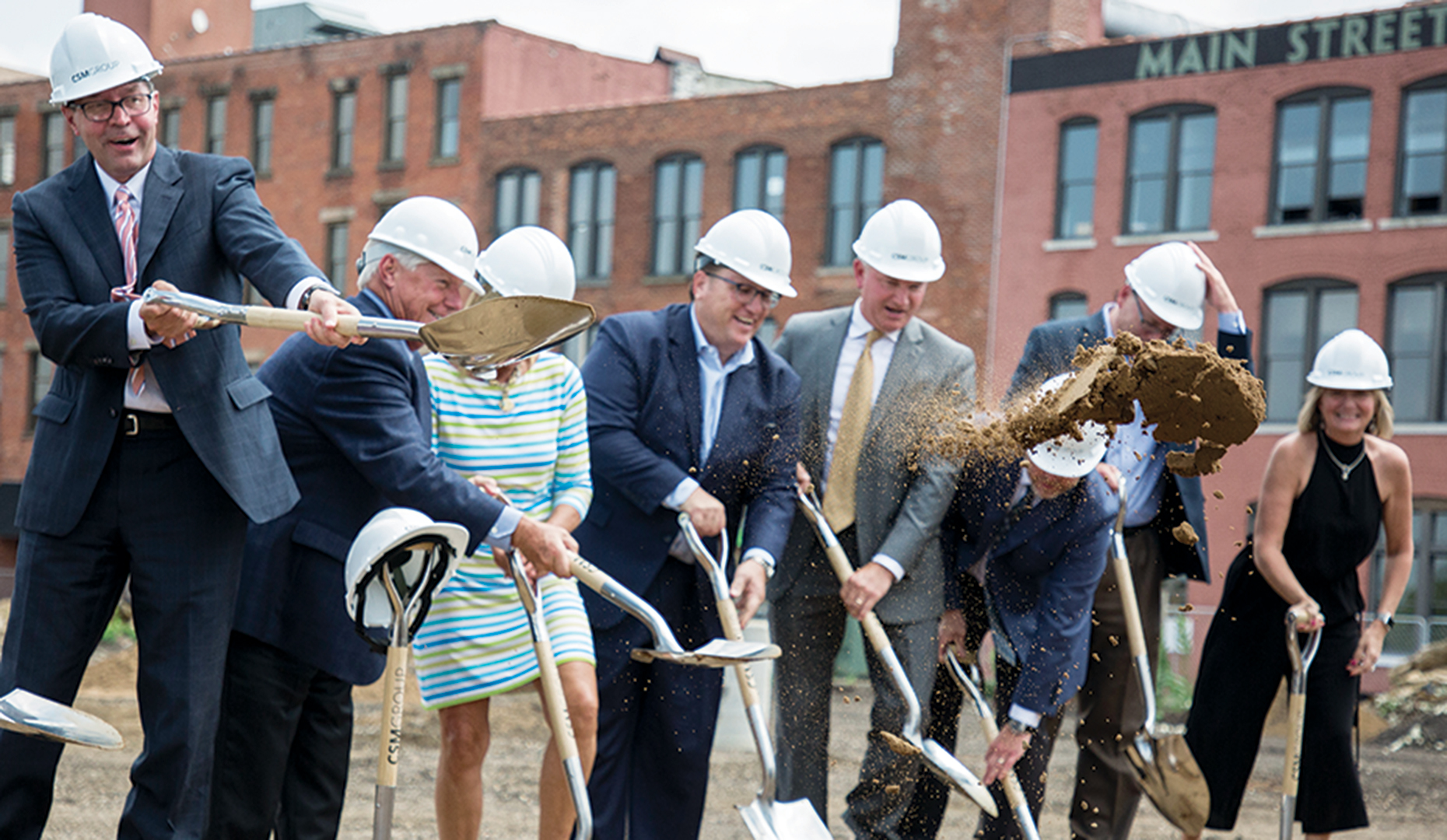How urban planning and revitalization will shape the future of Kalamazoo.
On a hot and hazy Thursday afternoon in August, a small crowd spilled from a white event tent on a construction site in Kalamazoo, Michigan. A dozen shovels jutted from the brown dirt nearby, symbols of the groundbreaking on 180 East Water Street, a $70 million, 290,000-square-foot mixed-use development. Patti Owens, vice president and managing director for Catalyst Development Co., the project’s lead developer, stepped to the podium.
A dozen shovels jutted from the brown dirt nearby, symbols of the groundbreaking on 180 East Water Street, a $70 million, 290,000-square-foot mixed-use development. Patti Owens, vice president and managing director for Catalyst Development Co., the project’s lead developer, stepped to the podium.
“Years in the making and involving over a dozen public and private development partners, 180 will be the realization of a vision
for meaningful, community-inclusive place-making in beautiful downtown Kalamazoo,” Owens pronounced.
The 180 East Water Street project, comprising commercial offices, residential units, and up to 310 parking spaces, is one of several tangible indications of growth and development in downtown Kalamazoo as public and private leaders develop partnerships to continue the city’s trajectory to become a place of choice for both living and working.
“We worked with the city to create a new street address for this site—180,” said Owens. “We feel this is a wonderful way to memorialize what will be a 180-degree transformation of the site when our project is completed.”
Andrew Haan, president of Kalamazoo Downtown Partnership, also spoke during the 180 groundbreaking on August 9. “This spot that we’re on today has been a parking lot since at least 1961,” he told the audience. “That really dates to an era when we treated our cities like we needed to try and compete with the suburbs on their terms. Knowing today that we’re competing on our own merit, we’re bringing [out] the individuality and the quality assets that we have. We’re not scared to compete as cities.”
The emergence of shiny new buildings from the remnants of history is emblematic of a community-wide urban redevelopment process that appeals equally to all sectors—developers; business owners and entrepreneurs; community and regional residents; state and local governments; institutions like colleges, universities, and hospitals; and non-profit economic development and planning agencies.
“We have to be a 24-hour active place,” Haan said in a subsequent interview. “We need relevant offerings for the entire community, whether that’s based on age or demographics or income or neighborhood of residence. Downtown is everyone’s neighborhood. It has to appeal very broadly. Downtown has to be accessible, easily navigable, and safe. It’s got to be walkable, with amenities within a short distance. We’re darn close to that. We’re at a point now where we’re seeing a massive influx of residential construction under way. The demand has been there for years, but in the last couple of years, we’re starting to see some serious commitment to this market from developers and lenders who are financing these projects.”
An increasing emphasis on strengthening the core city isn’t unique to Kalamazoo. Greg Holcombe, an Ann Arbor-based urban planner and consultant with Urban Innovations LLC, has worked in private planning in Michigan for more than 30 years. He says that urban planning works best when a small group of leaders are all pulling in the same direction.
“A common thread to successful urban planning and development is vision—a shared vision,” Holcombe said. “It’s hard to do anything significant if you don’t have a shared vision. That typically requires a planning process, at least by a small group of people who have thought about community issues and opportunities.”
Who’s in charge of change?
Another essential element to successful urban planning, Holcombe says, is public-private collaboration. “If you can get three or four people in a community—and that can be an elected official or just a sharp guy in the street, a philanthropist—you have a few key people, and you get those leaders together to talk about what is going on in the community, leading to a process or a vision. It can start with some place that somebody visited, pick your physical target, but suddenly there’s a spark and a creative conversation.”
Public-private partnerships are well, good, and necessary, but who or what should lead the urban planning and revitalization effort in Kalamazoo introduces a potential sticking point.
“In the past, it would have been families with names you’d recognize,” said Jeff Chamberlain, deputy city manager of Kalamazoo. “Those families are still in the area and still participate in the community, and we’re very grateful. But at a grassroots level, ‘number one’ is the small to medium-sized businesses that want to stay in Kalamazoo, want to grow, and are committed. It’s individuals and families that are pushing elected officials and city staff to say, ‘Here’s what we would like in our community.’”
But city officials should also push urban planning and redevelopment, Chamberlain says. “The city government is charged with looking at the city, as a whole, and how all the various pieces fit together,” he said. “We’re always approaching issues—whether somebody wants to develop a new apartment building on a lot or transform a corridor two miles long. The function of city government will always be to determine how all these pieces fit together. It’s always the high-level picture that we keep in mind.”
Chamberlain acknowledges the role of private organizations, too. “Kalamazoo Downtown Partnership, Southwest Michigan First, neighborhood associations, other organizations that focus on a specific area or topic—those groups are wonderful to have leading those types of projects. Our job at the city level is to say, ‘Hey, great idea! How do we fit than in with the bigger picture? How do we implement it?’”
Andrew Haan agrees that leadership must be cooperative. As head of the newly reinvented Kalamazoo Downtown Partnership, Haan sits at the hub where various interested parties intersect. His agency interacts with private developers, local and state government regulators, and community residents, and has a unique perspective on what the city center should be.
“It’s not about one leader, necessarily,” he said. “You want to have alignment between your major partners. And we do have alignment right now. Having forward-thinking leaders in the city—the business community, institutional partners, place managers, and economic developers—we have that.” Furthermore, public input is part of the mix, as well. “Not just downtown residents, but people who live throughout the city and the region, too. We need their buy-in.”
Getting along with the neighbors
Fritz Brown, a partner at Treystar, a family-owned real estate development and management firm, lives in Portage and sometimes identifies with the outliers.
“Bringing them along is a challenge,” Brown said. “You get people who want to take advantage of coming into the city for entertainment or dining opportunities, but they don’t want to go along when something’s on the ballot to make the downtown better. If it affects their pocketbook, they don’t want to support it.”
Brown argues that a booming city center and surrounding communities that thrive are interdependent. “Without a strong city inner core, your suburbs or neighboring towns suffer too,” Brown said. “To have a successful, economically viable community, you need a strong downtown.”
Brown values urban growth. Treystar recently completed The Foundry, a 52,000-square-foot office complex in Kalamazoo with loft-style brick walls, high ceilings, and a floor plan called “living office space”—a combination of open space and offices and meeting rooms. “Kalamazoo has come a long way,” Brown said. “I don’t remember when we’ve had two cranes in the air at the same time. I’m thrilled with all the activity, but it’s hard to bring your neighboring towns along at the same time.”
Andrew Haan also sees improvement in city-county relations. “Our success is their success,” he said. “Metro areas that have good, healthy urban cores have healthy exurbs and vice versa. You can’t have one without the other. We need to focus on those partnerships, and we have strong leadership in the county right now—they’re talking about a new courthouse and administration building in downtown, and that’s a very good alignment. For us to be successful, we have to have a place that has relevant offerings and is welcoming and comfortable for all people.”
The vision, the plan
One major component of the downtown planning and revitalization effort is Imagine Kalamazoo 2025, a recently completed outgrowth of the city’s 2012 state-mandated comprehensive plan. Document authors conducted more than 4,000 interviews with area residents to solicit input in prescribing the city’s future.
“It’s meant to be a forward-looking document that considers the values of our community, the things that we as the city and the private sector can do to make it better,” said Chamberlain. “Having a strategic vision really helps us, as city administrators and elected officials, to know what our values are as a community. What do we want to accomplish? For this intersection, do we or do we not want commercial development? What roads should have bike lanes, and which should not?”
To gather data for the vision document, city officials held public meetings in every corner of the city and sat down with neighbors to pore over block-by-block maps of specific areas. At the end of the process, they had gathered thousands of comments and suggestions. Eventually, that input coalesced into broad categories.
“As we go through the process, we identify which ideas relate to parks, which ideas relate to this neighborhood, which ideas relate to job creation,” Chamberlain said. “Over time, as we start grouping these comments, you start seeing themes. For example, this intersection is really dangerous to cross. A lot of people are concerned about the quality of sidewalks in their communities, on the west side and on the east side, so let’s start paying attention to that.”
Of course, not every idea will pass muster for inclusion in Imagine Kalamazoo 2025. “Kind of an outlier might be that someone wants a koala sanctuary in the city. We’re not dismissing that idea, but as we look at how we prioritize the city’s resources, it might not make the final cut.
Greg Dobson, chief operating officer and principal at AVB Inc., a commercial development firm, acknowledges the value of a primary planning document, with some qualifications. Dobson said he and other AVB executives didn’t play a major role in developing Imagine Kalamazoo 2025, but took part in “one or two” of the city’s input sessions.
“I wouldn’t say we agree with everything in the 2025 document, but I do think having some guiding principles is helpful,” Dobson said.
On August 22, AVB broke ground on its 400 Rose, LLC project—135 residential units over structured parking at the corner of Rose and Lovell. Dobson said the vision document helped steer the project’s design and development.
“As we were working on the project, we looked to see how our project would address some of the desired outcomes identified in the 2025 plan,” he said. “For example, our knowing that the city is desirous of having buildings that engage with the pedestrian street level impacts our total approach to the project; we pulled it all the way to the sidewalk. We are engaging the street with this development, so it feels walkable and pedestrian-friendly. This project was in the planning stages for four-and-a-half years. There are lots of ways you can develop 2.1 acres in the middle of downtown, but we were looking for the sweet spot where it was something the city was looking for and something we could make work from a market standpoint.”
Endgame
With ever more construction cranes punctuating Kalamazoo’s skyline, where will all the planning and redevelopment take the city?
“We have three new projects now—the Exchange Building, Catalyst Development, and ours, and they’re all adding residential units,” Dobson said. “I think it’s going to be interesting to see if that causes momentum for additional housing downtown or if that’s going to fill the need. Time will tell. I think it’s going to be pretty interesting to see if having housing—and the vibe those residences generate—will lead to more need or saturate it. That’s a question I can’t answer.”
Meanwhile, others ponder what successful urban planning looks like.
Greg Holcombe, the urban planning consultant from Ann Arbor, urges planners to “take advantage of urban dynamics. Don’t look back, don’t fall back on old successes. You’ve got to be collaborative and creative and move forward,” he says. “Be restless. Keep your eyes open for new opportunities, and address issues as they pop up.”
Andrew Haan of Kalamazoo Downtown Partnership says he shies away from specific metrics when measuring success. “The work is never done. Your downtown is never complete,” he said. “The work that was done 30 years ago to rehab historic buildings has to be done again. Streets and infrastructure always have to be fresh and inviting. To some extent, you can put metrics around it and have a scientific approach—things like occupancy, mix of uses, having a continued trend line for population growth. But you kind of just know you’re doing it right when you’re doing it.”




